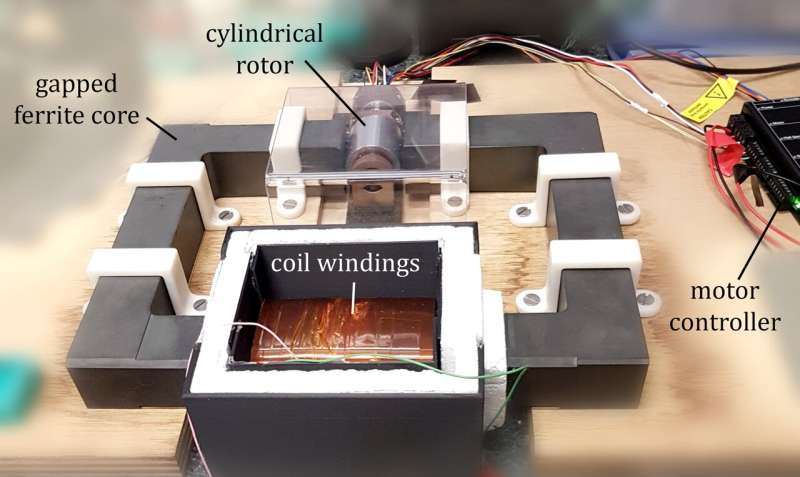
Physicists at the University of Southampton have tested and proven a 50-year-old theory for the first time using electro-magnetic waves. They have shown that the energy of waves can be increased by bouncing “twisted waves”—those with angular momentum—off of an object which is rotating in a specific way.
This is known as the “Zel’dovich effect,” named after Soviet physicist Yakov Zel’dovich who developed a theory based on this idea in the 1970s. Until now, it was believed to be unobservable with electromagnetic fields.
“The Zel’dovich effect works on the principle that waves with angular momentum, that would usually be absorbed by an object, actually become amplified by that object instead, if it is rotating at a fast enough angular velocity. In this case, the object is an aluminum cylinder and it must rotate faster than the frequency of the incoming radiation,” explains Research Fellow at the University of Southampton, Dr. Marion Cromb.
“Colleagues and I successfully tested this theory in sound waves a few years ago, but until this most recent experiment it hadn’t been proven with electromagnetic waves. Using relatively simple equipment—a resonant circuit interacting with a spinning metal cylinder—and by creating the specific conditions required, we have now been able to do this.”
The scientists’ findings are published in the journal Nature Communications .
The Zel’dovich effect is difficult to observe, but has links to a well-known phenomenon called the Doppler effect which we all experience around us every day.
Imagine you are standing on a busy road and a police car races towards you with its siren going. From your perspective, as it approaches, the siren sounds higher pitched than when it has passed.
This is because the sound waves in front of the car coming towards you are compressed at a high frequency—hence a higher pitch. Behind the car, as it moves away, they are more spread out at a lower frequency—resulting in a lower pitch. This is the Doppler effect.
This can also be applied to light waves. In fact, astronomers use it to understand whether a planetary body is moving toward, or away from the Earth, according to the frequency of the light waves seen from their point of observation.
A similar “rotational Doppler” frequency shift happens for twisted waves and relative rotation.
In the Zel’dovich effect, the metal cylinder needs to rotate fast enough that from its perspective it “sees” a “twisted wave “shift in angular frequency, so much that it actually goes to a negative frequency. This changes the way the wave interacts with the cylinder. Usually the metal would absorb the wave, but when the wave frequency “goes negative,” the wave is in fact amplified—reflecting off the cylinder with more energy than when it approached.
“The condition for amplification is from the rotating perspective of the object,” explains Marion Cromb. “Twisting electromagnetic fields hitting it have become rotationally Doppler shifted, so much (or so low) that they’ve gone through zero and into a ‘negative’ angular frequency. Negative frequency then means negative absorption, and this means amplification.”
The scientists say that proving the Zel’dovich effect in different physical systems, both acoustics and now electromagnetic circuits, suggests that it is quite fundamental in nature. Electromagnetic tests also pave the way to observing the effect on a quantum level, where the waves could be generated by the cylinder amplifying the quantum vacuum.
Professor Hendrik Ulbricht of the University of Southampton, supervisor on the project, said, “I am very pleased that we now have experimental proof of the electromagnetic Zel’dovich effect. In electromagnetic settings, it will be more straight forward to go for the next big challenge, which is the quantum version of the effect.”
“Our setup is comparably simple and it was my joy at work during COVID to set up this experiment and take the first data. To see the results out now is very rewarding and I am grateful to the fantastic team involved.”
The researchers also say their findings may be useful for electrical engineers in exploring improvements to induction generators, such as those used in wind turbines.
More information:
M. C. Braidotti et al, Amplification of electromagnetic fields by a rotating body, Nature Communications (2024). DOI: 10.1038/s41467-024-49689-w
Provided by
University of Southampton
Citation:
Scientists prove long-standing wave amplification theory (2024, September 9)
retrieved 9 September 2024
from https://phys.org/news/2024-09-scientists-amplification-theory.html
This document is subject to copyright. Apart from any fair dealing for the purpose of private study or research, no
part may be reproduced without the written permission. The content is provided for information purposes only.
